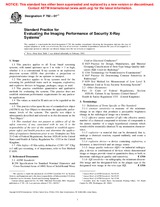We need your consent to use the individual data so that you can see information about your interests, among other things. Click "OK" to give your consent.
ASTM F792-01e1
Standard Practice for Evaluating the Imaging Performance of Security X-Ray Systems (Includes all amendments And changes 8/16/2017).
Automatically translated name:
Standard Practice for Evaluating the Imaging Performance of Security X-Ray Systems
STANDARD published on 10.10.2001
The information about the standard:
Designation standards: ASTM F792-01e1
Note: WITHDRAWN
Publication date standards: 10.10.2001
SKU: NS-56457
The number of pages: 6
Approximate weight : 18 g (0.04 lbs)
Country: American technical standard
Category: Technical standards ASTM
Annotation of standard text ASTM F792-01e1 :
Keywords:
contrast sensitivity, effective atomic number, explosive device, explosives, IQI, IQI sensitivity, organic differentiation, organic/inorganic differentiation, radiation chamber, radiation monitor, scatter block, security system, simple penetration, spatial resolution, thin organic imaging, useful organic differentiation, useful penetration, weapons, wire display, X-ray
Additional information
| Significance and Use | ||||||||||||||
|
This practice applies to and establishes a method to measure the imaging performance of X-ray systems used for the screening for prohibited items such as weapons, explosives and explosive devices in baggage, packages, cargo or mail. This practice is intended for use by manufacturers to assess performance and by evaluators of security and contraband screening X-ray systems to verify performance. This practice is intended to establish whether an X-ray system meets the manufacturer’specification or if the system’performance has deteriorated over time. This practice may be used for manufacturing control, specification acceptance, service evaluation or regulatory statutes. This practice is intended for use at both the point of manufacture and where the system is operated. The latter includes locations such as security checkpoints of transportation terminals, nuclear power stations, correctional institutions, corporate mailrooms, government offices and other security areas. The most significant attributes of this practice are the design of a standard Test Object and standard methods for determining the performance levels of the system. In screening objects with X-ray systems video images are the primary inputs provided to operators. The better the quality of these images, the better the potential performance of the operator. |
||||||||||||||
| 1. Scope | ||||||||||||||
|
1.1 This practice applies to all X-ray based screening systems, with tunnel apertures up to 1 m wide 1 m high, whether it is a conventional X-ray system or an explosives detection system (EDS) that provides a projection or projection/scatter image for an operator to interpret. 1.2 This practice applies to X-ray systems used for the screening for prohibited items such as weapons, explosives, and explosive devices in baggage, packages, cargo, or mail. 1.3 This practice establishes quantitative and qualitative methods for evaluating the systems. This practice does not establish minimum performance requirements for any particular application. 1.4 The values as stated in SI units are to be regarded as the standard. 1.5 This practice relies upon the use of a standard test object (ASTM X-ray Test Object) to determine the applicable performance levels of the systems. The specific test object is subsequently described and referred to in this document as the "Test Object." 1.6 This standard does not purport to address all of the safety concerns, if any, associated with its use. It is the responsibility of the user of this standard to establish appropriate safety and health practices and determine the applicability of regulatory limitations prior to use. Examples are Title 21 Code of Federal Regulations, Section 1020.40 in the United States and Health Safety Regulation No. 1333 in the United Kingdom. 1.7 Film Safety—If film safety, defined as 2.58x10-7 C/kg (1 mR) per screening, is of importance, refer to Test Method F 1039. |
||||||||||||||
| 2. Referenced Documents | ||||||||||||||
|



 Cookies
Cookies
